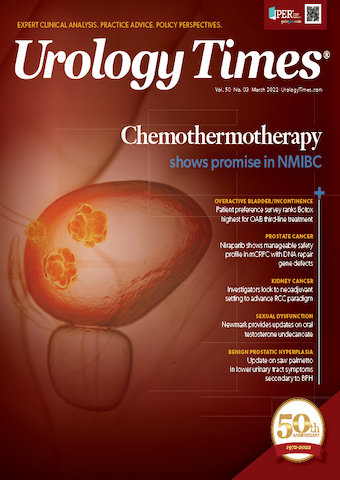Publication
Article
Urology Times Journal
Moving transperineal prostate biopsy into the clinic
Learning curve for technique is short, but capital expenditures are required.
Ashley E. Ross, MD, PhD

The diagnosis and management of prostate cancer remains a large part of virtually all urology practices. Prostate-specific antigen screening dramatically increased the number of men presenting with suspicion for prostate cancer, and transrectal ultrasound (TRUS)-guided prostate biopsy became routinely performed in our clinics.1,2 Over the past decade, it became clear that the diagnosis of clinically significant prostate cancer should be prioritized, as well as the development and implementation of fluid-based biomarkers, and prostate imaging with magnetic resonance imaging (MRI) currently allows for a reduction in unnecessary prostate biopsies (those diagnosing stage I prostate cancer or not identifying disease).3-5 Moreover, biopsies informed by MRI can increase the detection of clinically significant disease and reduce the need for repeat procedures.6
Edward M. Schaeffer, MD, PhD

Currently, most TRUS-guided prostate biopsies performed in the United States sample the prostate using a transrectal approach. The procedure is relatively well tolerated, aided by use of locoregional anesthesia applied to sensory branches of the pelvic plexus and by performing biopsies primarily above the dentate line. A significant limitation to this approach is the need to penetrate the rectal wall. Doing so results in an increased risk of postbiopsy infection and, most worrisomely, sepsis, which requires hospitalization and can cause significant morbidity. Indeed, risks of infection after transrectal prostate sampling during biopsy have been increasing, driven primarily by an increased in fluoroquinolone-resistant enterococcus in the population.7
Infection following transrectal approaches to prostate biopsy are estimated to occur in approximately 5% to 7% of cases and those requiring hospitalization in about 1% to 3% of cases.7,8 In a large study of men undergoing prostate biopsy within a single-payer system in Canada, hospitalization rates following biopsy was 2%, with 70% of these being infectious related.9 Infection rate increased more than 4-fold over the 10-year study period. This coincides with a doubling in the rate of fluoroquinolone-resistant E coli (FQRE) found in the rectal flora of men over the past decade. Currently, the rates of FQRE are between 10% and 20%, and men harboring these bacteria in their lower gastrointestinal tract have a 4-fold increased risk of postbiopsy infection.7
Techniques to mitigate infection risk
Several techniques have been described to limit infection following transrectal prostate biopsy, including povidone-iodine rectal preparation, the use of targeted prophylaxis based on rectal swabs, and augmented prophylaxis with multiple antibiotics. Infection rates remain higher with transrectal techniques despite these approaches, and use of antibiotics, particularly fluoroquinolones, is generally problematic. In Europe, fluoroquinolone use has been restricted since 2019, and in 2016, the FDA recommended limiting use of fluoroquinolones because of their “disabling and potentially serious adverse effects.”
Transperineal prostate biopsy under TRUS guidance moves the procedure to a clean rather than contaminated method for sampling prostate tissue, and thus can dramatically limit infection. In meta-analyses comparing transperineal with transrectal approaches, the rates of infection with transperineal approaches were reduced by approximately 2-fold, and rates of sepsis were reduced by approximately 9-fold.8,10 Guideline bodies advising interventional radiologists suggest antibiotics be omitted entirely for percutaneous procedures primarily because of the low risk of infection with such procedures and to enforce optimal antibiotic stewardship and reduce antibiotic resistance on a population level. Although most urologists continue to utilize antibiotics with transperineal approaches to prostate biopsy, recent evidence establishes the safety of omitting antibiotics entirely and should discourage their use. For instance, Sieta et al recently published a multi-institutional series of 450 consecutive patients undergoing transperineal biopsy without antibiotic prophylaxis and reported an infection rate of 0.44% (both urinary tract infections), with no patients requiring hospitalization.11 This rate mirrors smaller studies demonstrating no sepsis or infections requiring intravenous antibiotics following transperineal biopsies in smaller series.
Despite a lower risk of infectious complications, transperineal prostate biopsies have only recently seen increased routine use in diagnostic biopsy. One reason for a delay in implementation may have been the cumbersomeness and patient discomfort associated with traditional grid stepper approaches for perineal-based sampling. These approaches, most often used for saturation biopsy, utilize a grid placed against the perineum and a stepper stabilizer to hold and manipulate the transrectal ultrasound probe. As the stepper stabilizers decreases degrees of freedom for each biopsy, multiple needle punctures across the perineum are required, which translates into a large area of skin requiring anesthesia. Subsequently, these biopsies have been performed in the operating room under general anesthesia with operative times that approach 1 hour in length.12 The need for anesthesia increases both risk and cost to the patient. Furthermore, transperineal saturation biopsy, although the gold standard for biopsy detection of prostate cancer, is also associated with increased rates of urinary retention (potentially because of the use of general anesthesia and/or the use of extensive sampling).
Several access systems are available
Presently, freehand tethered transperineal access systems have been described and have become clinically available. These devices link a biopsy sheath to the biplanar ultrasound and allow for the flexibility of freehand biopsies while aligning the needle with the piezo electrodes in the sagittal plane.13 When compared with grid stepper systems, time of procedure is reduced by over 50%.14 These freehand systems, such as PrecisionPoint, are additionally compatible with multiple MR/US fusion platforms (eg, UroNav, bkFusion, Koelis Trinity). Importantly, as an access sheath with 1 entry point on either side of the patient’s perineum is used, freehand tethered systems allow for limited local and regional analgesia, and thus can be routinely performed in the clinical setting. In this regard, multiple techniques for anesthetizing the pain afferents to the prostate have been described.15 Many approaches recognize that afferents to the prostate and deep structures of the perineum from the pudendal nerve, perineal nerve, and pelvic plexus all run through the periapical triangle (bounded by the medial edge of the levator ani, the apical prostate, and urethral sphincter and external anal sphincter). Infiltration of lidocaine in this area can provide an extremely effective block, and buffering of lidocaine with NaHCO3 increases its potency by moving lidocaine molecules into their active noncationic form while decreasing the burning sensation experienced by many patients.
Beyond providing a lower rate of serious infectious complications, transperineal prostate biopsies may provide improved diagnosis of clinically significant prostate cancer. In relatively small series, transperineal biopsy approaches have demonstrated increased detection rates when compared with transrectal techniques.16,17 Much of this may be secondary to an increased ability to sample the anterior and apical prostate, an area that may be more difficult to assay in transrectal approaches. Furthermore, in contemporary series comparing freehand tethered perineal biopsy approaches to grid stepper perineal biopsy approaches, diagnostic rates of clinically significant prostate cancer were not compromised.14 Of additional note, use of a freehand rather than grid-based technique resulted in a 10-fold lower rate of urinary retention (1% vs 10%) and greatly reduces procedural time.
Stepwise innovations have thus allowed for transperineal TRUS-MR fusion-guided prostate biopsies to be performed routinely in our clinical practices. Currently, our practice is to perform these procedures routinely in the clinic without antibiotics, with local/regional buffered lidocaine as the only analgesic, and with short procedural times. Although evidence and personal experience suggests this approach is well tolerated with lower complications and high diagnostic yield, formal study of transperineal vs transrectal MRI-targeted biopsies is ongoing in a multi-institutional randomized trial (NCT04815876). Even if transperineal biopsy is favored in this study, there will be barriers to implementation. Thankfully, the learning curve for performing transperineal biopsies is short. However, adoption of the technique in our clinics requires capital expenditures for biplanar ultrasound probes and compatible machines, as well as an increased per-case cost for disposables, such as the probe tether and access sheath. Urologists are currently absorbing these additional costs, as no unique Current Procedural Terminology code for transperineal biopsies performed in the office exists.
References
1. Hodge KK, McNeal JE, Terris MK, Stamey TA. Random systematic versus directed ultrasound guided transrectal core biopsies of the prostate. J Urol.1989;142(1):71-75. doi:10.1016/s0022-5347(17)38664-0
2. Siegel RL, Miller KD, Fuchs HE, Jemal A. Cancer statistics, 2021. CA Cancer J Clin.2021;71(1):7-33. doi:10.3322/caac.21654
3. Eklund M, Jäderling F, Discacciati A, et al. MRI-targeted or standard biopsy in prostate cancer screening. N Engl J Med.2021;385(10):908-920. doi:10.1056/NEJMoa2100852
4. Kasivisvanathan V, Rannikko AS, Borghi M, et al. MRI-targeted or standard biopsy for prostate-cancer diagnosis. N Engl J Med.2018;378(19):1767-1777. doi:10.1056/NEJMoa1801993
5. Eyrich NW, Morgan TM, Tosoian JJ. Biomarkers for detection of clinically significant prostate cancer: contemporary clinical data and future directions. Transl Androl Urol.2021;10(7):3091-3103. doi:10.21037/tau-20-1151
6. Ahdoot M, Wilbur AR, Reese SE, et al. MRI-targeted, systematic, and combined biopsy for prostate cancer diagnosis. N Engl J Med.2020;382(10):917-928. doi:10.1056/NEJMoa1910038
7. Liss MA, Edhaie B, Loeb S, et al. An update of the American Urological Association white paper on the prevention and treatment of the more common complications related to prostate biopsy. J Urol.2017;198(2):329-334. doi:10.1016/j.juro.2017.01.103
8. Pilatz A, Veeratterapillay R, Dimitropoulos K, et al. European Association of Urology position paper on the prevention of infectious complications following prostate biopsy. Eur Urol.2021;79(1):11-15.doi:10.1016/j.eururo.2020.10.019
9. Nam RK, Saskin R, Lee Y, et al. Increasing hospital admission rates for urological complications after transrectal ultrasound guided prostate biopsy. J Urol.2010;183(3):963-968. doi:10.1016/j.juro.2009.11.043
10. Pradere B, Veeratterapillay R, Dimitropoulos K, et al. Nonantibiotic strategies for the prevention of infectious complications following prostate biopsy: a systematic review and meta-analysis. J Urol.2021;205(3):653-663. doi:10.1097/JU.0000000000001399
11. Setia SA, Smith J, Cendo D, et al. Outcomes of freehand transperineal prostate biopsy with omission of antibiotic prophylaxis. BJU Int.2021; 10.1111/bju.15590. doi:10.1111/bju.15590
12. Bhanji Y, Allaway MJ, Gorin MA. Recent advances and current role of transperineal prostate biopsy. Urol Clin North Am.2021;48(1):25-33. doi:10.1016/j.ucl.2020.09.010
13. Meyer AR, Joice GA, Schwen ZR, Partin AW, Allaf ME, Gorin MA. Initial experience performing in-office ultrasound-guided transperineal prostate biopsy under local anesthesia using the PrecisionPoint Transperineal Access System. Urology.2018;115:8-13. doi:10.1016/j.urology.2018.01.021
14. Urkmez A, Demirel C, Altok M, Bathala TK, Shapiro DD, Davis JW. Freehand versus grid-based transperineal prostate biopsy: a comparison of anatomical region yield and complications. J Urol.2021;206(4):894-902. doi:10.1097/JU.0000000000001902
15. Basourakos SP, Allaway MJ, Ross AE, Schaeffer EM, Hu JC, Gorin MA. Local anaesthetic techniques for performing transperineal prostate biopsy. Nat Rev Urol. 2021;18(6):315-317. doi:10.1038/s41585-021-00443-7
16. Ber Y, Segal N, Tamir S, et al. A noninferiority within-person study comparing the accuracy of transperineal to transrectal MRI-US fusion biopsy for prostate-cancer detection. Prostate Cancer Prostatic Dis.2020;23(3):449-456. doi:10.1038/s41391-020-0205-7
17. Pepe P, Garufi A, Priolo G, Pennisi M. Transperineal versus transrectal MRI/TRUS fusion targeted biopsy: detection rate of clinically significant prostate cancer. Clin Genitourin Cancer.2017;15(1):e33-e36. doi:10.1016/j.clgc.2016.07.007

Newsletter
Stay current with the latest urology news and practice-changing insights — sign up now for the essential updates every urologist needs.
































